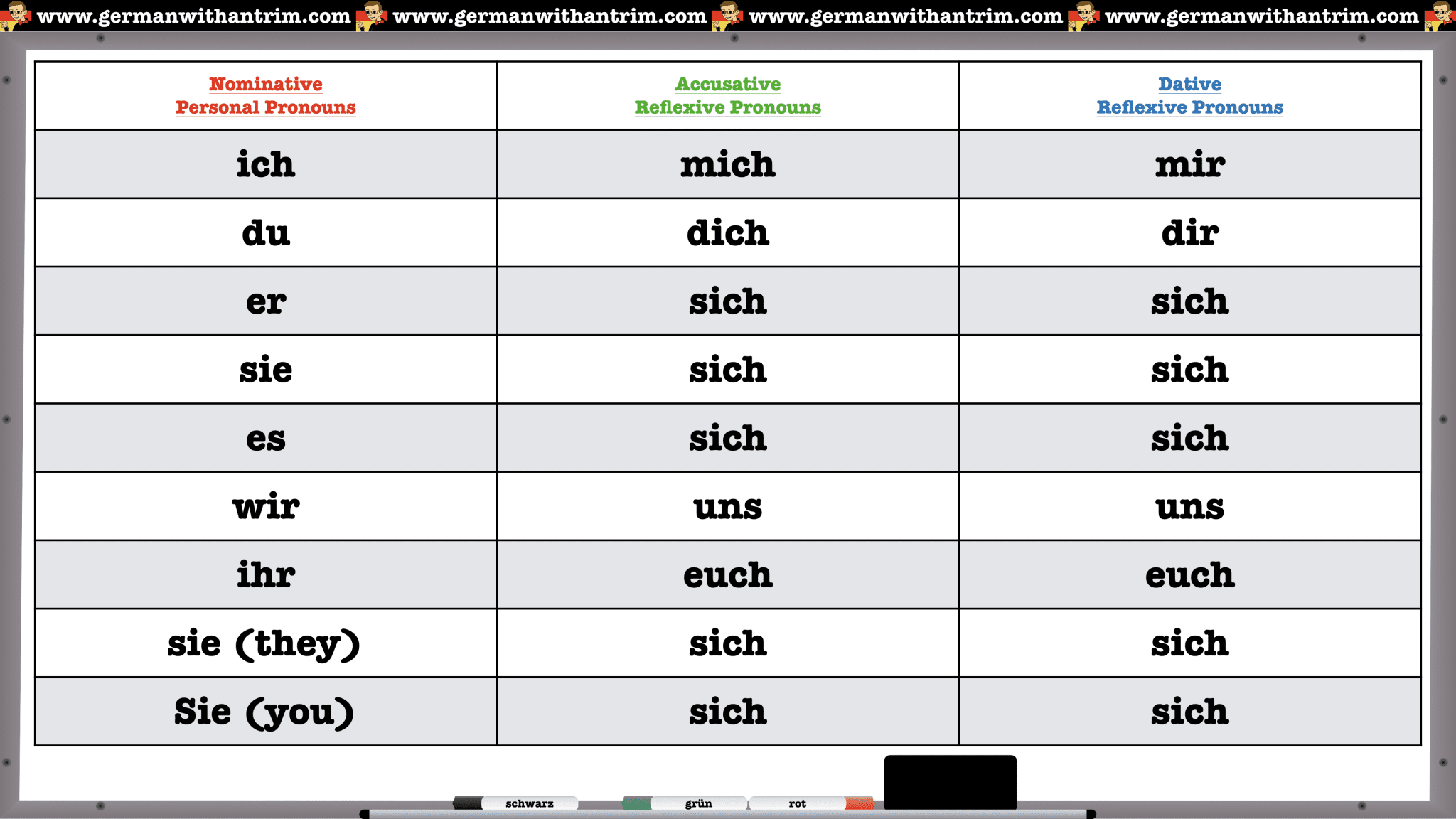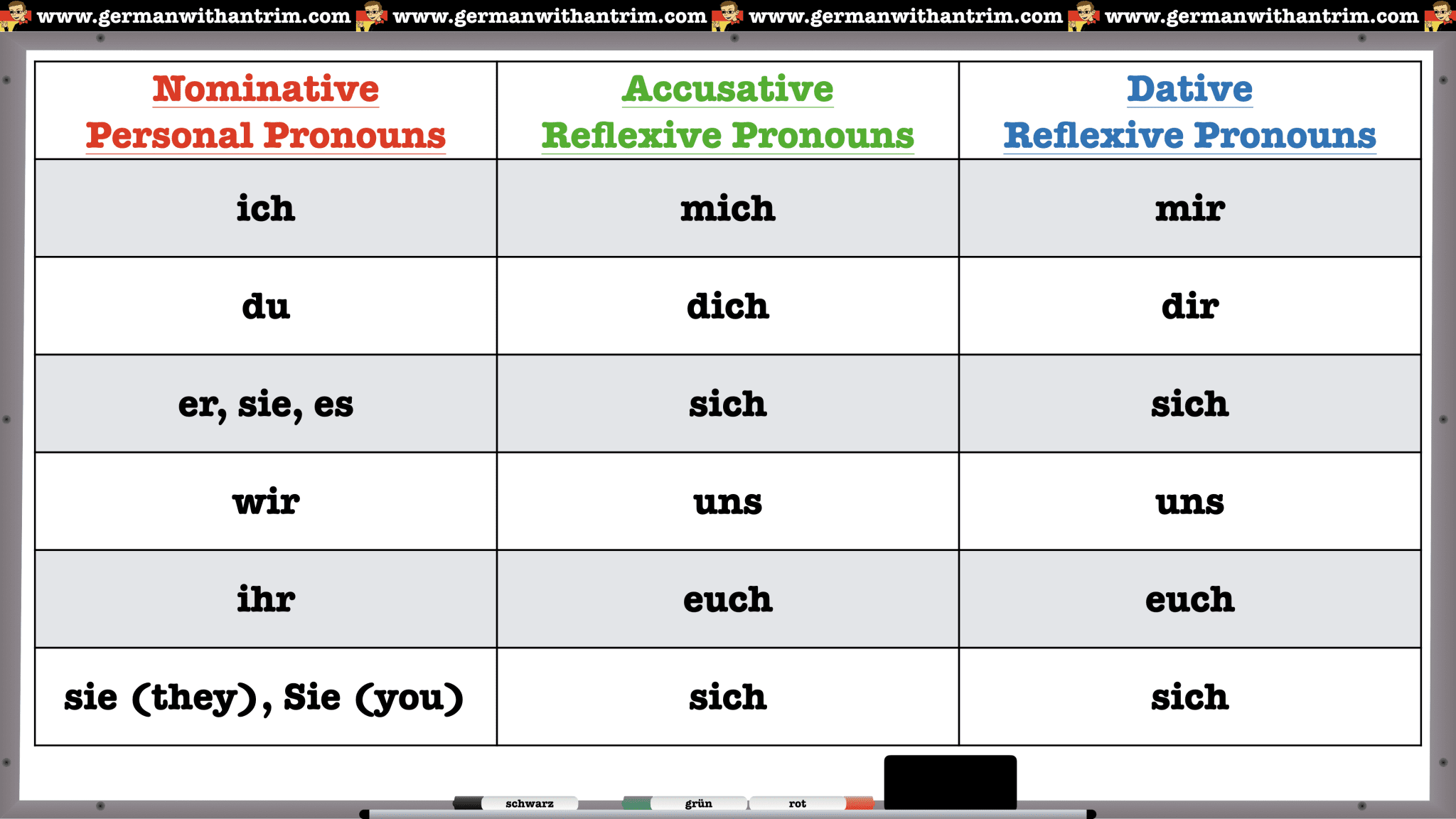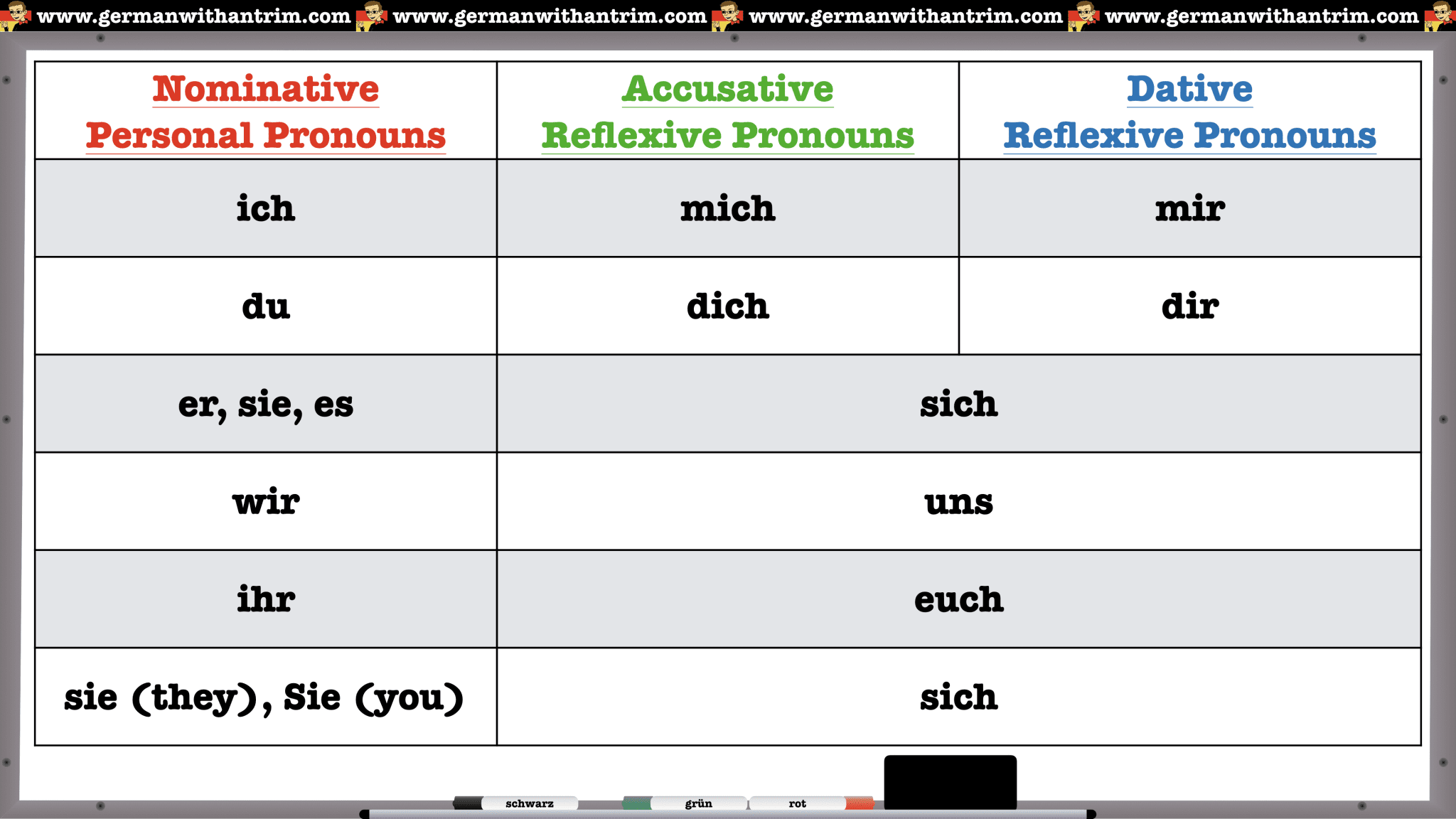Your Ultimate Guide to Reflexive Pronouns & Reflexive Verbs in German
If you are struggling to understand reflexive pronouns and reflexive verbs in German, this post is guaranteed to explain everything you need to know about them. In this post I will explain the pronoun “sich”, what it means to use a reflexive pronoun, why reflexive verbs even exist in German and a whole lot more.
This post is one of several about the reflexive pronouns and what normal teachers call the “reflexive verbs” in German. If you are ready to take the deep dive into the reflexive pronouns, take a look at all of the articles in this series about the reflexive forms in German.
- Your Ultimate Guide to the Reflexive Pronouns & Reflexive Verbs in German
- Reflexive Pronouns Listening Comprehension Skit & Song
- Reflexive Verbs Don’t Exist Explanation
- 62 German Reflexive Verb Example Sentences

If you are really wanting to put your German learning on track, consider joining Herr Antrim’s Deutschlerner Club! For just $14.99 per month you will get access to his full A1 and A2 courses plus new materials as he creates them. You will go from knowing zero German to being able to have a short conversation in a short few weeks. Before you know it, you will be conversational in German on a variety of important topics, all while mastering German grammar.
What are reflexive pronouns?
Reflexive pronouns are words used in place of a noun as the object of a sentence when both the subject and the object are the same person, place or thing.
Most of the time, reflexive pronouns are used with people, but it is possible to use them in other circumstances. In German, they very closely resemble the personal pronouns in the accusative and dative cases with some exceptions. There are links in the previous sentence to lessons about those two groups of pronouns, but I’ll review them a bit in this post, as well.
Some teachers refer to verbs that require reflexive pronouns as “reflexive verbs”. I personally don’t do that, but if you are looking for a list of the most common “reflexive verbs” in a downloadable PDF list, you can download that here for FREE.
Why do we need reflexive pronouns in German?
First let’s look at an example of a reflexive pronoun in use, so we understand why we need them.
Er rasiert sich. –
He shaves himself.
This is a pretty basic example. There is a subject, “er”, and an object “sich”. The subject is shaving the object and the subject and object are the same person.
Ok, but why can’t we just say “He shaves.” like we would in English? Why do we need to identify the person or thing being shaven?
The verb “rasieren” requires an object. You can’t just shave in German. You have to identify the person or object that is being shaven. It’s just how the verb works.
Ok, so why can’t you just say: He shaves his face. – Er rasiert sein Gesicht.
The problem here is that we can’t be 100% sure that the “er” and “sein” refer to the same person. If you didn’t know, it is pretty customary for families to request that someone shave their family members while in a coma, so that they continue to look the way the family remembers them. If the person shaving is masculine and the person being shaven is masculine, the sentence “Er rasiert sein Gesicht.” would be used to express this situation.
So, I’m using a reflexive pronoun to show that I’m not shaving someone else’s face?
Pretty much, yeah.
Well, how would I say “He is shaving his face.” with the intent that both the “he” and “his” are referring to the same person?
Er rasiert sich das Gesicht. – He shaves his face.
Why “das Gesicht” and not “sein Gesicht”?
Well, it would be a bit redundant. You already identified whose face it is by using the reflexive “sich”. This tells us that the person being shaven is the same “he” as the subject. Once you have done that, you just need to identify the part of that person that is being shaven, which is “das Gesicht”.
That said, the sentence “Er rasiert sich sein Gesicht.” is a pretty normal way of phrasing this same expression. You can express it either way, but the reflexive pronoun must still be there, no matter which version you use.
What are the reflexive pronouns in German?
Now that you have wrapped your brain around the “why”, let’s talk about the “how”. If you are familiar with the personal pronouns in German, you will know that there are nine of them in each of the nominative, accusative and dative cases. If you know those, you already know 4 of the nine rows of this chart.
The only change between the personal pronouns charts and the reflexive pronouns charts is the word “sich”. This word is kind of the de facto reflexive pronoun. When people want to illustrate that a verb is being used reflexively, they use the pronoun “sich” to indicate this. This is why you usually see “sich” next to verbs that are often used reflexively.

The pronoun “sich” is used for all of the third person reflexive forms. These forms are the “er”, “sie”, “es” and plural “sie” pronouns. The formal you “Sie” form also uses the pronoun “sich”. This is easily explained by past me in my A1 Beginner Course video.
I want to mention one little side note about the formal “you” pronoun “Sie” and the third person plural pronoun “sie”. The pronoun that is now used as the formal “you” in German is actually derived from the third person plural “sie”, which is “they” in English. This comes from the idea that if you were to show someone respect back in the olden days, you shouldn’t address them directly at all, which means that “Sie” is less a formal version of “you” than a capitalized version of “they”. This also explains the reason they are always the same and they take the same form of verbs.
– Herr Antrim
Standard German Reflexive Pronouns Chart
If you look up a chart of reflexive pronouns in German, you will likely see a chart similar to this one.

Condensed German Reflexive Pronouns Chart
With all of the times that “sich” is used in this chart, you can actually condense the reflexive pronouns chart down to 6 rows instead of the standard 9. Now our chart looks like this.

Super-Condensed German Reflexive Pronouns Chart
Some teachers condense this even further, because most of the pronouns are the same between the accusative and dative cases. Then the chart looks like this.

This is my personal favorite version of the reflexive pronouns chart. I leave the nominative personal pronouns column in there for reference and combine as much of the chart as I can. This way you don’t have to memorize as much stuff. If the subject uses one of the nominative case personal pronouns, use the corresponding reflexive pronoun when you need one. Obviously, you can also figure out which reflexive pronoun to use by finding which nominative case personal pronoun would replace the noun or nouns that are the subject in any given sentence.
Example Sentences with Reflexive Pronouns in German
Let’s try some more examples.
Ich dusche mich. –
I am showering (myself).
Ich is the subject, so the reflexive pronoun must be from the same row in the chart. I used the accusative one here, but I’ll explain when to use each case in a few minutes.
Zieh dich um! –
Change your clothes.
Here I used a command, which removes the pronoun “du” from the sentence. This does not change the reflexive pronoun, however. We still need a reflexive pronoun to match the invisible subject “du” in this sentence. Again, I chose the accusative case version, but more on that in a bit.
Mein Bruder putzt sich die Zähne. –
My brother is brushing his teeth.
If you replace “mein Bruder” with a pronoun, you would use “er” in this sentence. So we need a reflexive pronoun from that row. The only one there is “sich”.
Die Frau bürstet sich die Haare. –
The woman is brushing her hair.
If you replace “die Frau” with a pronoun, you would use “sie”. Again, the only reflexive pronoun in the same row is “sich”.
Das Mädchen konzentriert sich auf die Hausaufgaben. –
The girl concentrates on the homework.
Wir freuen uns auf das Wochenende. –
We are looking forward to the weekend.
Ihr werdet euch erkälten. –
You will catch a cold.
Die Schüler ärgern sich über die Hausaufgaben. –
The students are becoming annoyed about the homework.
Regen Sie sich nicht so auf! –
Don’t get so agitated.
As you can see in those examples, the subject and object are the same person, so we use the reflexive pronouns that are in the same row.
When to Use Accusative and Dative Reflexive Pronouns in German
Now let’s figure out which column to use. When do we use the accusative and when do we use the dative pronouns?
The deciding factor between accusative and dative reflexive pronouns is the presence of a direct object or the lack thereof. If there is already an object in the sentence before you add in the reflexive pronoun, the reflexive must be dative, as the other object takes the accusative spot. If there is not another object, however, the reflexive pronoun is used in the accusative case. For example:
Ich wasche mich. –
I am washing myself.
Here the only object is the reflexive pronoun, mich. We used the accusative case, because there is no other object.
Ich wasche mir die Hände. –
I am washing my hands.
In this sentence, the hands are the direct object, which puts them in the accusative spot. The only space left for the reflexive is in the dative case. So I used “mir” instead of “mich” for this one.
You can also think of the default position for reflexive pronouns as the accusative case, as they represent the direct object of the sentence. When you add in an additional object, that object takes on the role of the direct object and the reflexive pronoun is now in the position of the indirect object, therefore dative.
sich vorstellen + Accusative or Dative?
Stell dir ein Einhorn vor! –
Imagine a unicorn.
This sentence has the word “Einhorn” as the direct object, which forces the reflexive pronoun to use the dative case.
The verb “vorstellen” can be a bit confusing. For example you might say something like this:
Stell dir vor, du bist der Lehrer. –
Imagine you are the teacher.
You don’t see a direct object in this sentence, but the clause after the comma sort of acts like the direct object of the sentence, which puts the reflexive pronoun into the dative case.
There is also another version of the verb vorstellen. If you use the accusative case with your reflexive pronoun with this verb, the translation becomes “to introduce oneself”. For example:
Stell dich vor! –
Introduce yourself.
Reflexive Pronouns with Prepositional Phrases
Some students of German are confused when there is a prepositional phrase in the sentence. In English we sometimes think these are acting like direct objects, so students want to use the dative reflexive pronouns, but this is not the case. Here is an example of what I mean.
Ich gewöhne mich an meine neuen Schuhe. –
I am getting used to my new shoes.
One might think that the shoes are the direct object in this sentence, but in German the preposition “an” is used. The shoes are simply the object of that preposition. They are not the direct object. The only direct object in this sentence is “mich”, the accusative reflexive pronoun.
Another verb that acts like this is erinnern – to remember. It is paired with the preposition “an” to express that you remember something. For example:
Ich erinnere mich an mein erstes Auto. –
I remember my first car.
This is especially confusing, as the English translation does use the car as the direct object of the sentence, while the German sentence keeps the “Auto” in the prepositional phrase with “an”. The reflexive pronoun, therefore, is accusative.
Reflexive Pronouns and Two-Way Prepositions
One of the cool things about reflexive pronouns is their impact on several phrases with the two-way prepositions. When you use a two-way preposition in a sentence with a reflexive pronoun, there is a good chance that you need the accusative case for both the reflexive pronoun and the object of that two-way preposition. Let me show you what I mean.
Setz dich an den Tisch! –
Sit down at the table.
The reflexive pronoun is used here, because the verb “setzen” requires you to identify what is being “set”. This is the direct object. When the thing being “set” is the same as the subject, you use the reflexive pronoun. Since the prepositional phrase is expressing a change in the location of that direct object, the two-way preposition is used with the accusative case.
Ich lege mich eine Weile auf das Sofa. –
I am laying down on the sofa for a while.
This sentence always confused me as a German student. Why is there a reflexive pronoun at all here? Why does the preposition require the accusative case? How does any of this make sense with the words “eine Weile”? If you are laying down for a while, that doesn’t describe a change in location, in my mind. In reality, there is a bit more going on here.
Similar to the verb “setzen”, the verb “legen” requires a direct object. If the subject is the same as that direct object, you need the reflexive pronoun. Since the verb itself indicates a change in location for the direct object, the preposition describes that as well. This makes the prepositional phrase require the accusative case, as it shows “to where” the “mich” is being laid down. The words “eine Weile” simply tell us how long I intend on remaining in my new location. This does not affect the case of either the reflexive or the two-way preposition.
Reflexive Pronouns in the Imperative Form (Commands)
The last version of things I want to talk about is something I mentioned earlier. When you use a reflexive pronoun as a command, you have to remember what the subject is. This is a bit tricky with the du- and ihr-form commands, as they require that you remove the pronoun when you form them. This is sometimes confusing to German learners. Let’s take a look at a few commands in various forms with reflexive pronouns to see how they work.
Commands with Du
Beeil dich! –
Hurry up.
Here we used the du-form command. In a regular statement, the sentence would be “Du beeilst dich. – You are hurrying.” When we change this to a command, we remove the pronoun “du” and the -st at the end of the verb. The reflexive pronoun remains in the sentence and matches the subject that is not actually said/written in the sentence.
Commands with Ihr
Kümmert euch um das Baby! –
Take care of the baby.
In this one, I used the ihr-form command. The regular statement version would be “Ihr kümmert euch um das Baby. – You are taking care of the baby.” In the command, we simply remove the pronoun “ihr”. The reflexive pronoun still matches that subject, even though it is not explicitly said/written in the command.
Commands with Sie
Fürchten Sie sich nicht vor meinem Hund! –
Don’t be afraid of my dog.
In this one, we can clearly still see the pronoun “Sie”, so it is less confusing than the previous two examples. The reflexive pronoun matches the subject “Sie”, just as the other sentences matched their subjects.
Hopefully this post has helped you understand how to use the reflexive pronouns in German. It still might not be entirely clear when to use them, however. If you wished that this post had more example sentences in it, just continue on to the next page. I used a variety of subjects and subject pronouns along the way to show you how each of the reflexive pronouns are used. I also incorporated Präsens, Futur 1 and Perfekt tenses. I even threw in a few commands and modal verbs just for good measure. It is quite possibly the most complete post about what normal teachers call “reflexive verbs” that you will ever see.
More Reflexive Pronouns & Verbs Lessons
This post is one of several about the reflexive pronouns and what normal teachers call the “reflexive verbs” in German. If you are ready to take the deep dive into the reflexive pronouns, take a look at all of the articles in this series about the reflexive forms in German.
- Your Ultimate Guide to the Reflexive Pronouns & Reflexive Verbs in German
- Reflexive Pronouns Listening Comprehension Skit & Song
- Reflexive Verbs Don’t Exist Explanation
- 62 German Reflexive Verb Example Sentences

If you are really wanting to put your German learning on track, consider joining Herr Antrim’s Deutschlerner Club! For just $14.99 per month you will get access to his full A1 and A2 courses plus new materials as he creates them. You will go from knowing zero German to being able to have a short conversation in a short few weeks. Before you know it, you will be conversational in German on a variety of important topics, all while mastering German grammar.
German Lessons in Your Inbox
New lessons, motivation, and tips delivered to your inbox.
Unless it is fried, we don't want no spam around here. If you fill out this form, you will simply get the best German lessons, motivation and tips. That's all.


